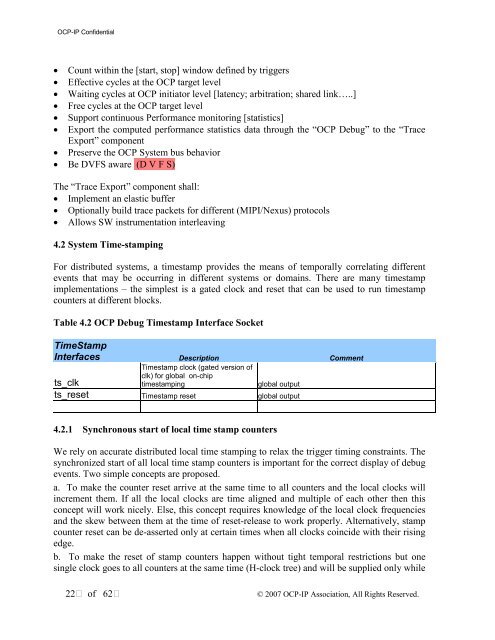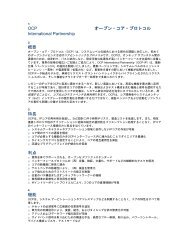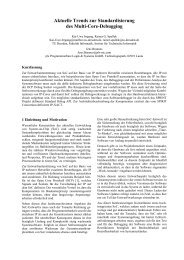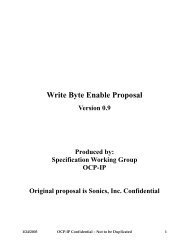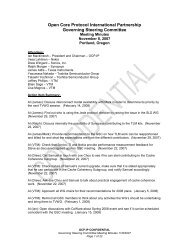Open Core Protocol Debug Interface Specification rev 1.0 - OCP-IP
Open Core Protocol Debug Interface Specification rev 1.0 - OCP-IP
Open Core Protocol Debug Interface Specification rev 1.0 - OCP-IP
Create successful ePaper yourself
Turn your PDF publications into a flip-book with our unique Google optimized e-Paper software.
<strong>OCP</strong>-<strong>IP</strong> Confidential<br />
• Count within the [start, stop] window defined by triggers<br />
• Effective cycles at the <strong>OCP</strong> target level<br />
• Waiting cycles at <strong>OCP</strong> initiator level [latency; arbitration; shared link…..]<br />
• Free cycles at the <strong>OCP</strong> target level<br />
• Support continuous Performance monitoring [statistics]<br />
• Export the computed performance statistics data through the “<strong>OCP</strong> <strong>Debug</strong>” to the “Trace<br />
Export” component<br />
• Preserve the <strong>OCP</strong> System bus behavior<br />
• Be DVFS aware (D V F S)<br />
The “Trace Export” component shall:<br />
• Implement an elastic buffer<br />
• Optionally build trace packets for different (M<strong>IP</strong>I/Nexus) protocols<br />
• Allows SW instrumentation interleaving<br />
4.2 System Time-stamping<br />
For distributed systems, a timestamp provides the means of temporally correlating different<br />
events that may be occurring in different systems or domains. There are many timestamp<br />
implementations – the simplest is a gated clock and reset that can be used to run timestamp<br />
counters at different blocks.<br />
Table 4.2 <strong>OCP</strong> <strong>Debug</strong> Timestamp <strong>Interface</strong> Socket<br />
TimeStamp<br />
<strong>Interface</strong>s Description Comment<br />
ts_clk<br />
Timestamp clock (gated version of<br />
clk) for global on-chip<br />
timestamping<br />
global output<br />
ts_reset Timestamp reset global output<br />
4.2.1 Synchronous start of local time stamp counters<br />
We rely on accurate distributed local time stamping to relax the trigger timing constraints. The<br />
synchronized start of all local time stamp counters is important for the correct display of debug<br />
events. Two simple concepts are proposed.<br />
a. To make the counter reset arrive at the same time to all counters and the local clocks will<br />
increment them. If all the local clocks are time aligned and multiple of each other then this<br />
concept will work nicely. Else, this concept requires knowledge of the local clock frequencies<br />
and the skew between them at the time of reset-release to work properly. Alternatively, stamp<br />
counter reset can be de-asserted only at certain times when all clocks coincide with their rising<br />
edge.<br />
b. To make the reset of stamp counters happen without tight temporal restrictions but one<br />
single clock goes to all counters at the same time (H-clock tree) and will be supplied only while<br />
22 of 62<br />
© 2007 <strong>OCP</strong>-<strong>IP</strong> Association, All Rights Reserved.


